A recurring cipher of Danish painter VilhelmHammershøi (Copenhagen, 1864 - 1916) is the depiction of a woman alone, often from the back or in profile, immersed in the silence of gray-toned interiors. It is no coincidence that the artist has been called the painter or the "poet of silence," since his works are really poems, compositions in whichintrospection, solitude, and reflection dominate: lyrical elements often found in poetic production at the turn of the 19th and 20th centuries, where theself becomes central to understanding the movements and anxieties of thehuman soul.
Nordic suggestions that lower the viewer into an intimate dimension, into the stillness of daily life taking place in a home: here the female figure plays the piano, looks out the window, arranges flowers in a vase, sews or simply sits pensively. These are images that convey a certain melancholy, as there is no cheerfulness or dialogue, only silence. For this reason Hammershøi’s art has been compared to that of another painter of silence and solitude, but of American origin and slightly later than the Danish painter: Edward Hopper (Nyack, 1882 - New York, 1967). In the latter’s works, too, theabsence of voices is perceived, not only when only one person is depicted, but also when there is more than one, as in the case of Room in New York or Summer in the City; unlike Hopper’s works, which appear more colorful in tone, even if the atmosphere is anything but cheerful, as in the case of Automat, Morning Sun or Compartment, Hammershøi’s paintings are almost monochromatic, favoring shades of gray. Nevertheless, they are representative of a particular rendering of light, called precisely "Nordic light," frequently used in Scandinavian paintings at the turn of the nineteenth and twentieth centuries: a veiled glow enters from the home’s windows, from the typically tall windows with white wooden surrounds, giving the interiors a dim luminosity. It is the northern European sunshine filtering shyly, creating plays of lighter and darker hues. A “symphonic range of grays,” as it has been called, that gives the idea of the Nordic twilight light that envelops everything it encounters, from the landscape to the interiors of architecture. It would be characteristic of Finland, but it is extendable to all of Northern Europe, the expression pitäähämärää, which translated into English would sound like “keeping the twilight,” or sitting in silence where the twilight light spreads, as a moment of contemplation and reflection: Indeed, recurring often in Nordic painting is the motif of a human figure sitting in front of a window observing what is outside, while filtering through the panes this soft light reflecting off the furniture and the floor. This motif is reminiscent, as already stated, of one of Hopper’s most famous works, Morning Sun, where a girl, having just woken up, looks out a large window while sitting on her bed: the view certainly gives a view of a city, since the top of a building can be seen, so it is perceived that the room the girl is in is part of an even taller building. The sunlight powerfully invades the room and is directed particularly toward the bed and the girl.
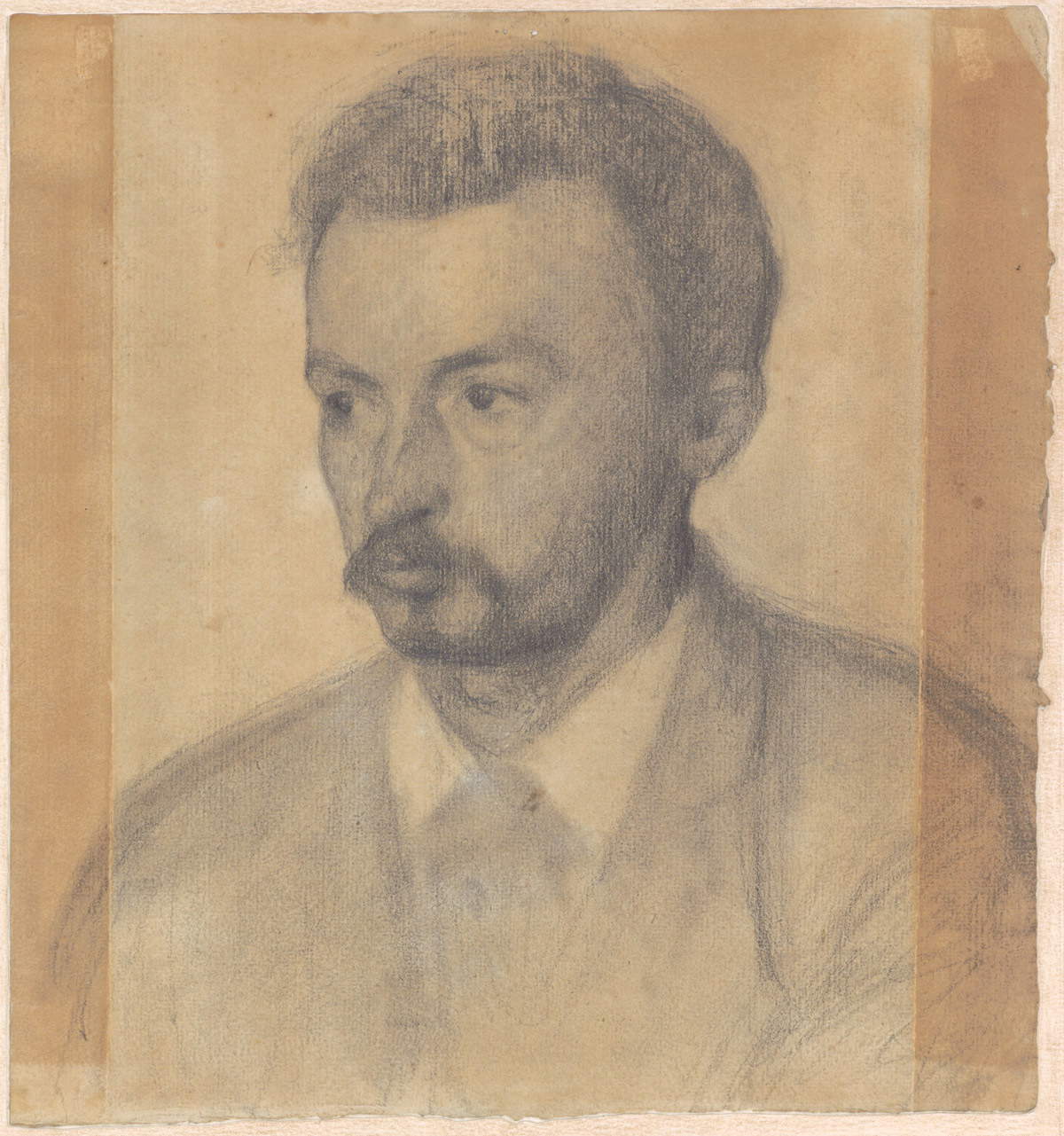 |
| Vilhelm Hammershøi, Self-Portrait (1895: black stone on ochre paper, 24.20 x 22.9 cm; Paris, Custodian Foundation, Frits Lugt Collection) |
 |
| Vilhelm Hammershøi, Sunbeam in Salon, III (1903; oil on canvas, 54 x 66 cm; Stockholm, Nationalmuseum) |
 |
| Edward Hopper, Room in New York (1926-1932; oil on canvas, 73.5 x 91.5 cm; Lincoln, Shaldon Museum of Art, University of Nebraska) |
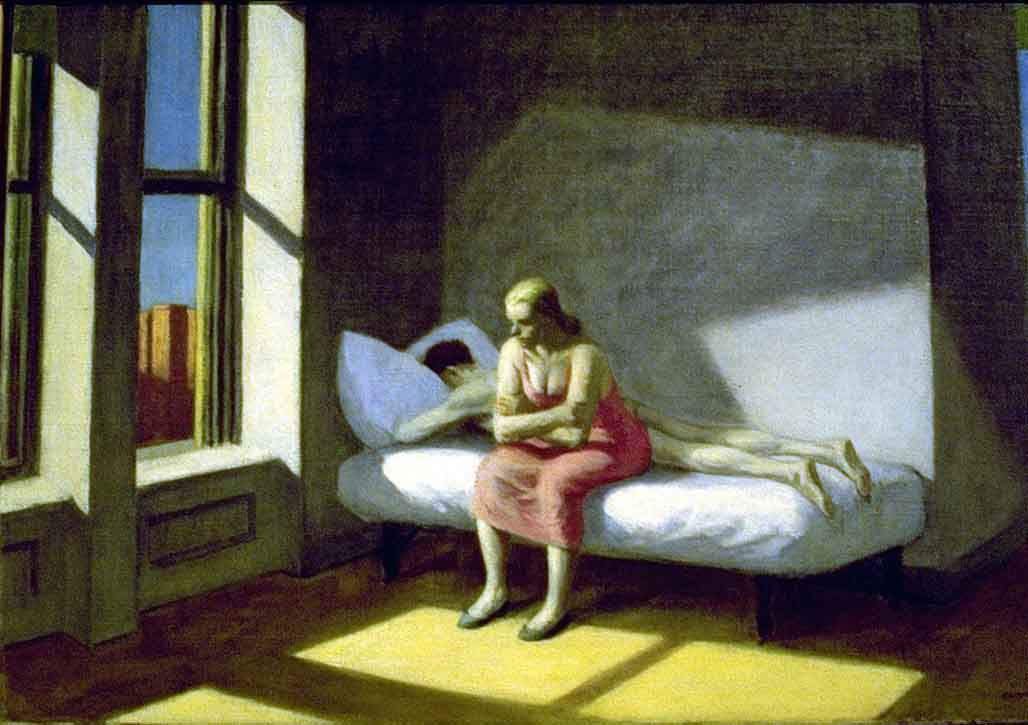 |
| Edward Hopper, Summer in the city (1950; oil on canvas, 76 x 51 cm; Private collection) |
 |
| Edward Hopper, Morning sun (1952; oil on canvas, 101.98 x 71.5 cm; Columbus, Columbus Museum of Art) |
While the comparison with Hopper is fitting as, in a sense, an anticipator of the American painter’s art, however, a proximity to the art of Jan Vermeer (Delft, 1632 - 1675), among the best known and most beloved Dutch artists of the seventeenth century, has also been advanced. Although the two artists are more than two centuries apart chronologically, Vermeer’s works actually have something in common with Hammershøi’s: the depiction of female figures intent on domestic activities, such as sewing, reading, and playing musical instruments, is found in both. Recall in this regard, among the Dutch artist’s works, The Lacemaker, The Lute Player, Woman Standing at the Spinet, Girl Interrupted During Music Lesson, Woman Writing a Letter in the Presence of the Maid, but many others could be mentioned, for in the seventeenth century the so-called genre painting flourished in Holland, which emphasized scenes of everyday life, where time stopped on those moments of domestic poetry. Also frequent in Vermeer is the presence of a window through which natural light filters into the environment in which the figures go about their activities. Although the rooms appear in most cases more furnished and decorated than in the Danish artist’s interiors, in which either no furniture is visible or there is a limited amount of it: mostly a chair, a table or at most a sideboard or desk. What is also never missing are the interior doors, which are always white, as the Nordic tradition dictates: sometimes the perspective with which the room has been depicted allows more than one to be seen, perhaps open to other rooms, while from the windows the landscape outside is almost imperceptible.
Hammershøi could thus be called a continuer of Vermeer’s genre painting and a forerunner of Hopper’s painting of solitude, but that would be too reductive: the Danish artist is endowed with a uniquely introspective sensibility, combined with a pronounced lyricism in melancholy tones and theinfluence of his home country in terms of light and color, as well as the architecture of the interiors.
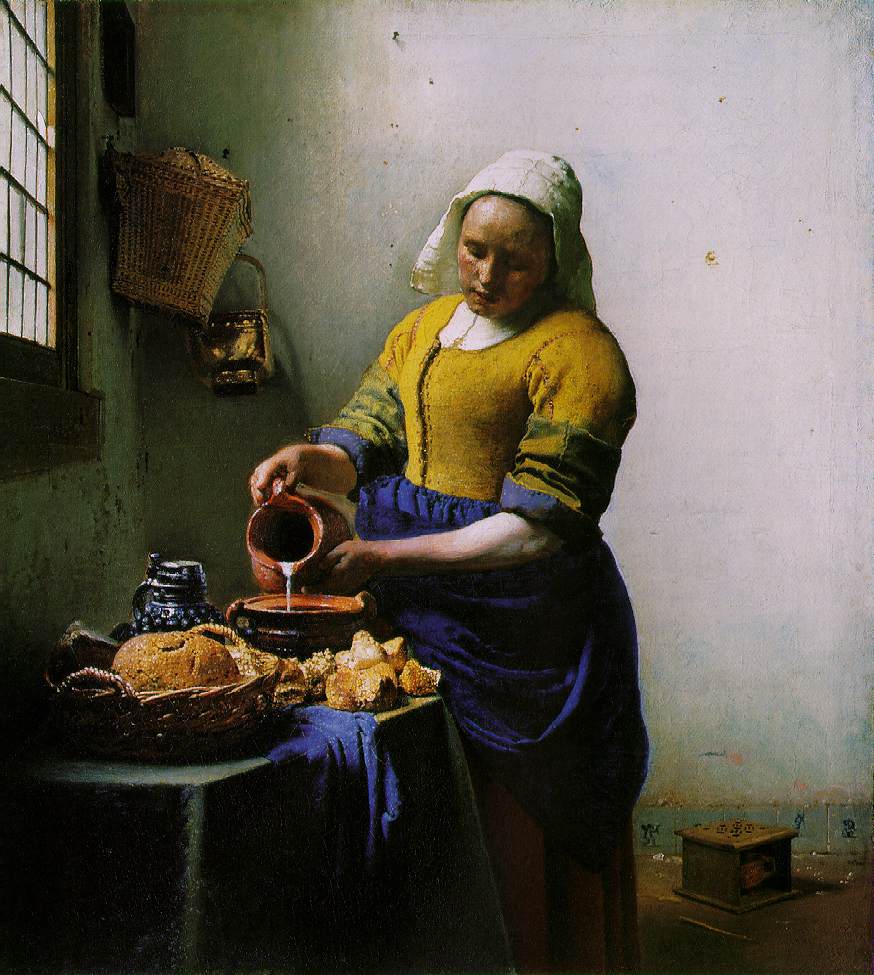 |
| Jan Vermeer, The Milkmaid (c. 1658-1660; oil on canvas, 45.4 x 40.6 cm; Amsterdam, Rijksmuseum) |
 |
| Jan Vermeer, Woman Standing at the Spinet (1672; oil on canvas, 51.8 x 45.2 cm; London, National Gallery) |
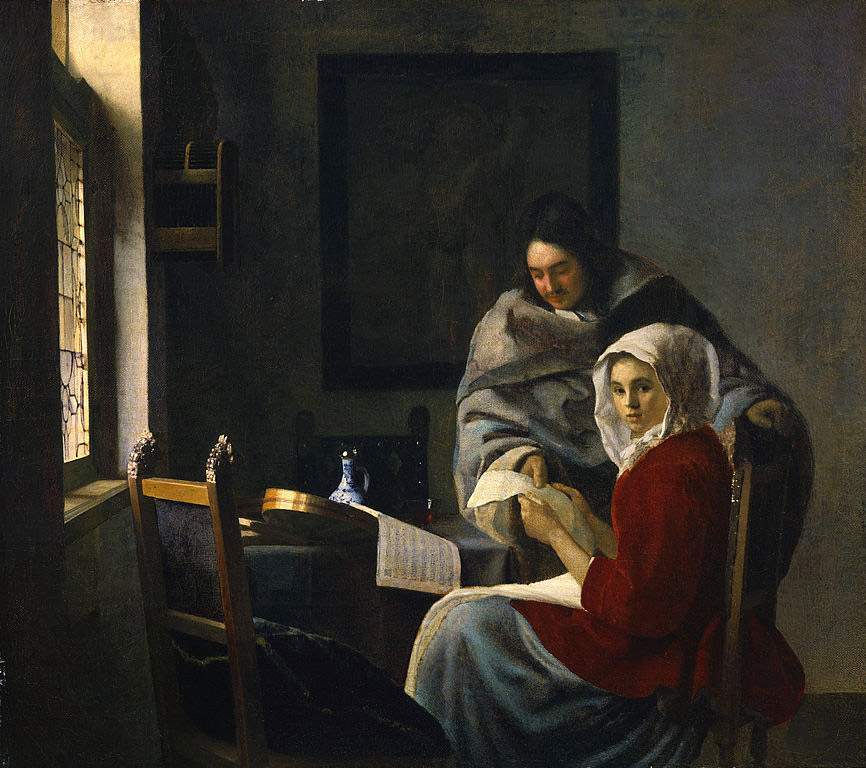 |
| Jan Vermeer, Girl interrupted during music lesson (c. 1660; oil on canvas, 39.3 x 44.4 cm; New York, Frick Collection) |
Nevertheless, the artist has remained little known outside of northern Europe; presented at the Petit Palais in 1987, it was in 1997 that the major retrospective devoted to him by the Musée d’Orsay made the public and critics rediscover Hammershøi’s art, and now, more than two decades later, it is still the city of Paris that is paying homage to him: in fact, the retrospective Hammershøi, le maîtrede la peinture danoise at the Musée Jacquemart-André is on view until July 22, 2019.
Born in Copenhagen on May 15, 1864, he was introduced to drawing at a very young age through the Danish draftsman and lithographer Niels Christian Kierkegaard (Copenhagen, 1806 - 1882). During his years of study at the Academy, he forged strong friendships with Carl Holsøe (Aarhus, 1863 - Asserbo, 1935) and Peter Ilsted (Sakskøbing, 1861 - Copenhagen, 1933), artists with whom he remained close until his death and known for depicting mostly domestic interior scenes.
After studying with Peder Severin Krøyer (Stavanger, 1851 - Skagen, 1909), he first participated in the Academy’sspring exhibition and competition for the Academy’s Neuhaus Prize in 1885 by presenting Portrait of a Young Girl, which was none other than Anna, the artist’s sister. He later had the opportunity to travel and visit Berlin, Dresden, as well as Holland and Belgium: it was here that he was probably thunderstruck byDutch art, particularly Vermeer, whose art would be an inspiration to him, as mentioned earlier.
He found love in Ida Ilsted, sister of his fellow academy student Peter Ilsted, who would become Vilhelm’s wife and model: often the woman portrayed from behind or in profile in his characteristic domestic interiors is Ida herself. Together they moved to Paris, not forgetting to pass through Holland and Belgium, countries that had remained in his mind and heart; in the French capital Hammershøi often visited the Louvre, particularly to copy archaic Greek bas-reliefs, and it was here that he met the famous dealer Paul Durand-Ruel, the one who was among the Impressionists’ greatest supporters, and the art critic Théodore Duret, who took an interest in his painting. After returning to Copenhagen, he received a scholarship from the Academy to travel in 1893 and visited some Italian cities, such as Florence, Siena, Padua, Venice and Verona, and four years later they stayed for a few months in London.
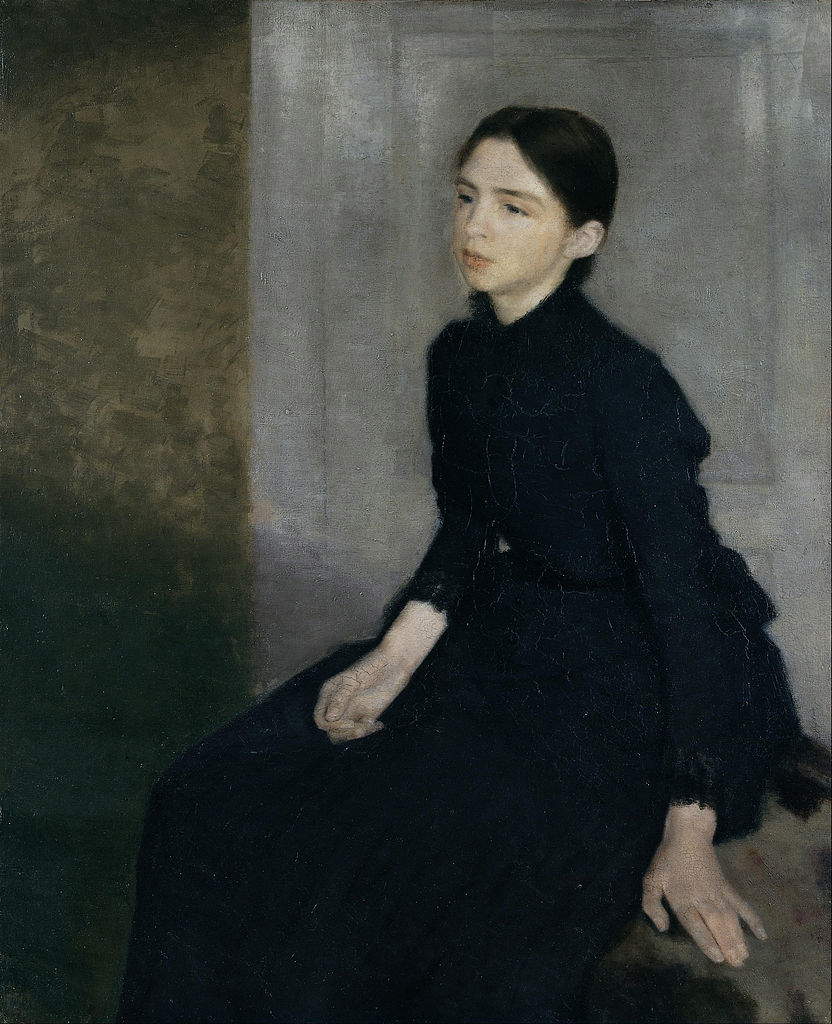 |
| Vilhelm Hammershøi, Portrait of a Young Girl (1885; oil on canvas, 91.5 x 112 cm; Copenhagen, Den Hirschsprungske Samling) |
 |
| Vilhelm Hammershøi, Portrait of Isa Ilsted (1890; oil on canvas, 106.5 x 86 cm; Copenhagen, Statens Museum for Kunst) |
He made his first “interior” in 1888, but it was from ten years later that he would paint a significant amount, since he moved with his wife to the apartment at Strangade 30, which they inhabited from 1898 to 1909.
At the Kunstforeningen (the Copenhagen Arts Society) his first retrospective is held, an occasion when collector Alfred Bramsen compiles the first list of his works. In addition, it is thanks to the English pianist Leonard Borwick that Hammershøi is introduced toBritish art circles. He later became a member of the general assembly of the Academy, and in 1911 he received the first prize of 10 thousand liras at theInternational Art Exhibition in Rome, and the Uffizi even commissioned him to paint a self-portrait for display in the collection of artists’ self-portraits. Suffering from throat cancer, Hammershøi died in Copenhagen in 1916.
Throughout his existence, he formed strong bonds with a few people who remained close to him until his passing; he was a solitary and taciturn person, an aspect that is also reflected in his works, in which he depicts a world in his own image, intimate and silent. In his paintings, he therefore portrayed those who were part of the inner circle of his affections, starting with his wife Ida, and mostly involving members of his family, such as his mother, sister, brother, brother-in-law, as well as a few almost-brotherly friends.
It is his brother Svend who is portrayed standing while reading composedly a book, leaning against a long yellow curtain, thus implying that he is near a window. Next to the boy, on the wall facing the viewer is a kind of writing desk with a white wooden chair in front of it; above the piece of furniture are two paintings framing two drawings of male bodies: perhaps harking back to the beginnings of the artist’s production, whose training began with drawing. Interior with Young Man Reading (Svend Hammershøi) is an oil on canvas painted in 1898.
The long series of canvases in which he depicts Ida begins in 1890, when he portrays her, still as his fiancée, sitting facing the viewer. Against a neutral background, she appears clad in a black robe, a hat of the same color over her close-cropped hair, and a jacket that communes with the wall. The girl’s gaze is fixed and absent, as if the artist refuses to express his model’s feelings.
 |
| Vilhelm Hammershøi, Interior with Young Man Reading (Svend Hammershøi) (1898; oil on canvas, 64.4 x 51.8 cm; Copenhagen, Den Hirschsprungske Samling) |
Still seated, but this time with her back to the viewer, Ida is depicted in the famous 1905 canvas at the Musée d’Orsay: Hvile also known as Rest. The painting, constructed mainly in shades of gray, shows the young woman in the foreground next to a piece of furniture on which a flower-shaped cup rests. What stands out, however, is her snow-white nape, left free by her close-cropped hair. Based on vertical and horizontal lines, on the other hand, is Interior with Woman from Behind, from 1898, kept at the Nationalmuseum in Stockholm. Ida is standing, back to back, behind a table covered by a white tablecloth; on the wall can be seen a writing desk and hanging an oval mirror that breaks the order of the lines but reflects the void. The exposed white nape of the neck stands out against the black dress.
As already stated, many of his interiors were made in the apartment at Strandgade 30: an example is the 1901 canvas Interior. Strandgade 30 preserved in Frankfurt am Main. The special feature of this painting is the presence of several doors, three to be precise, all open, allowing the viewer to glimpse the different rooms accessed through them. In the foreground is the room that gives the perspective of the composition, where there is only a chair, leaning against the paneling, and hanging on the same wall are two small paintings; from the central door we can then see another room where the woman stands, in half-light and with her back turned, and a further door from which we access another windowed room. These open doors give a sense of three-dimensionality and spatiality.
A similar composition is repeated in Interior with Standing Woman: the tones, compared to the previous painting, become lighter, thanks to the soft light from a window. The viewer’s perspective is once again that of a room with wood paneling from which, through an open door, there is access to a second room, one where the presence of a window in front of which the female figure is standing can be perceived. However, the door that can be glimpsed further in the distance is closed, leaving implied the existence of a further space that remains unseen.
In Interior with Woman Arranging Flowers, made in 1900, Ida is instead caught in a moment of domestic work: she is arranging flowers in a transparent vase, itself on a table. Portrayed in another moment of domestic quiet is in the painting Interior with Woman at the Piano: in the foreground is a table with a white tablecloth on which two plates (Ida’s and the artist’s?) rest, while leaning against the wall is a piano at which the woman is playing. Unlike the works mentioned above, the woman’s face is visible here and appears thoughtful and somewhat melancholy. Behind her can be seen a large stove and at the sides two closed doors, which do not allow other rooms to pass through.
Hammershøi also brought to the canvas interiors where no human presence is manifest, or rather, it is not visible in the painting, but from the décor and the reflection of the open window on the wall, it is presumably not far away. This is the case in Interior with vase of flowers, the latter placed on the table in the center of the scene.
 |
| Vilhelm Hammershøi, Hvile or Rest (1905; oil on canvas, 49.5 x 46.5 cm; Paris, Musée d’Orsay) |
 |
| Vilhelm Hammershøi, Interior with Woman from Behind (1898; oil on canvas, 51.5 x 46 cm; Stockholm, Nationalmuseum) |
 |
| Vilhelm Hammershøi, Interior. Strandgade 30 (1901; oil on canvas, 66 x 55 cm; Frankfurt am Main, Städel Museum) |
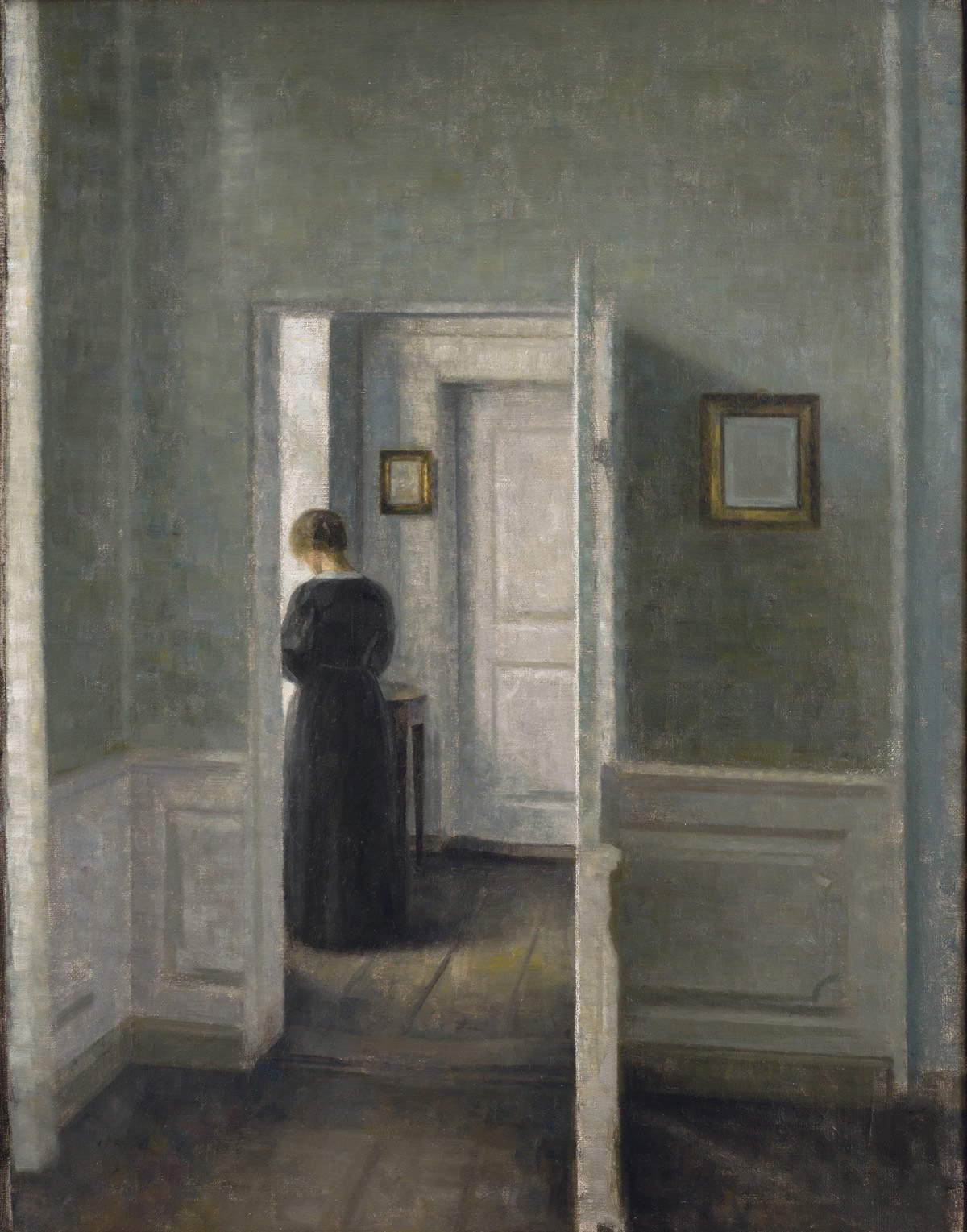 |
| Vilhelm Hammershøi, Interior with Standing Woman (s.d.; oil on canvas, 67.5 x 54.3 cm; Ambassador John L. Loeb Jr. Danish Art Collection) |
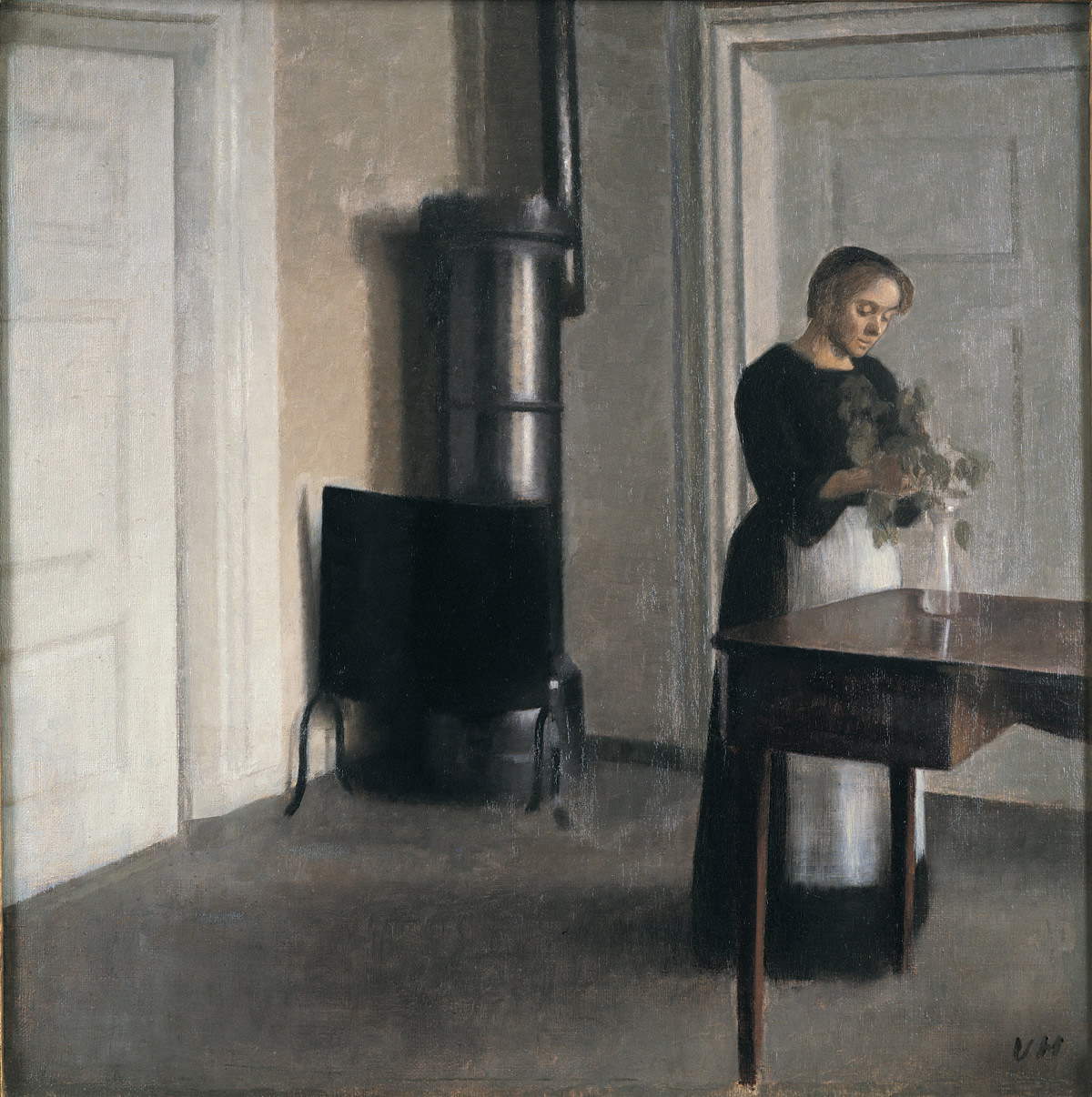 |
| Vilhelm Hammershøi, Interior with woman arranging flowers (1900; oil on canvas, 40 x 30 cm; Ambassador John L. Loeb Jr. Danish Art Collection) |
 |
| Vilhelm Hammershøi, Interior with Flower Vase (1910-1911; oil on canvas, 78.5 x 71 cm; Malmö, Malmö Konstmuseum) |
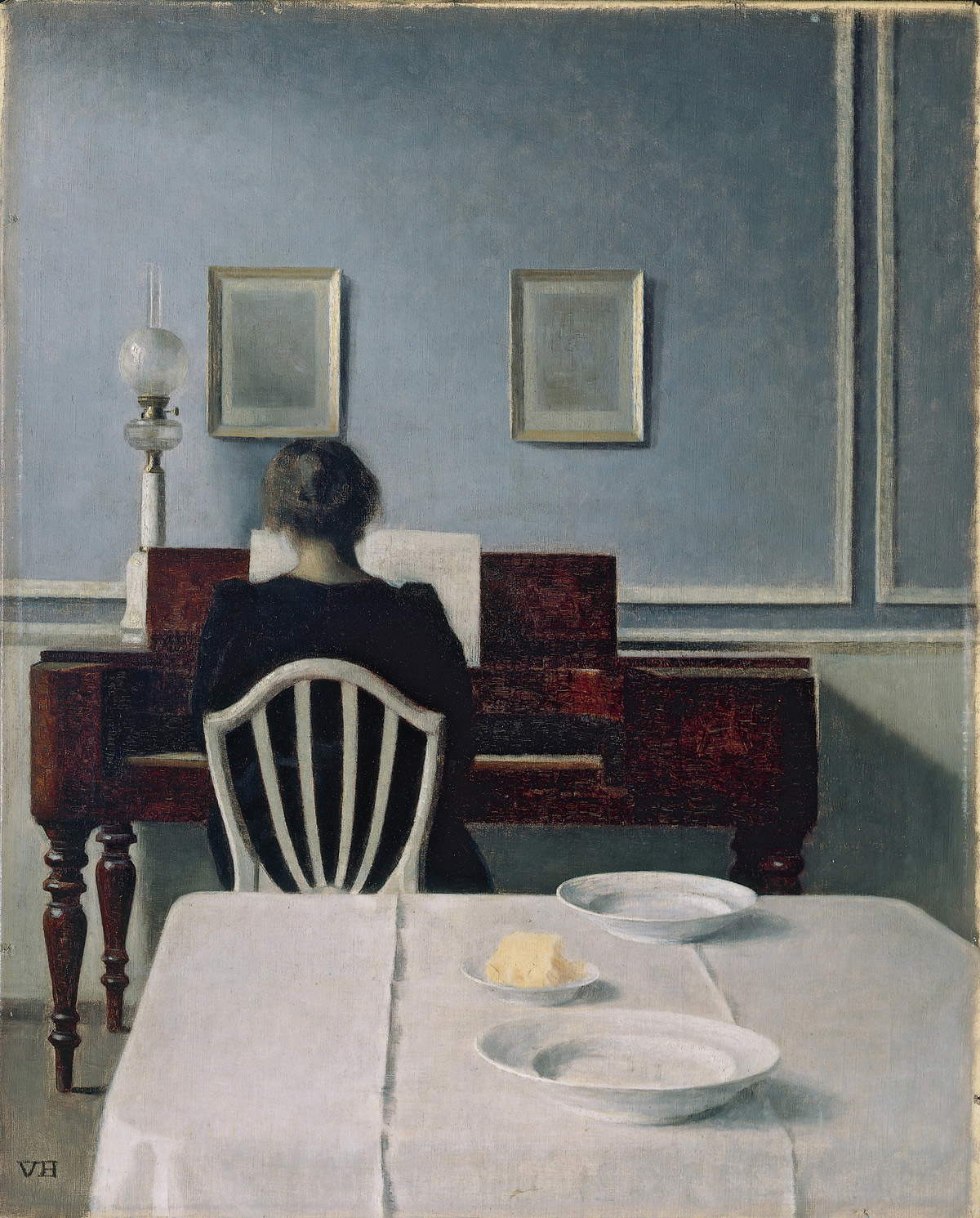 |
| Vilhelm Hammershøi, Interior with Woman at the Piano (1901; oil on canvas, 55.9 x 44.8 cm; Private Collection) |
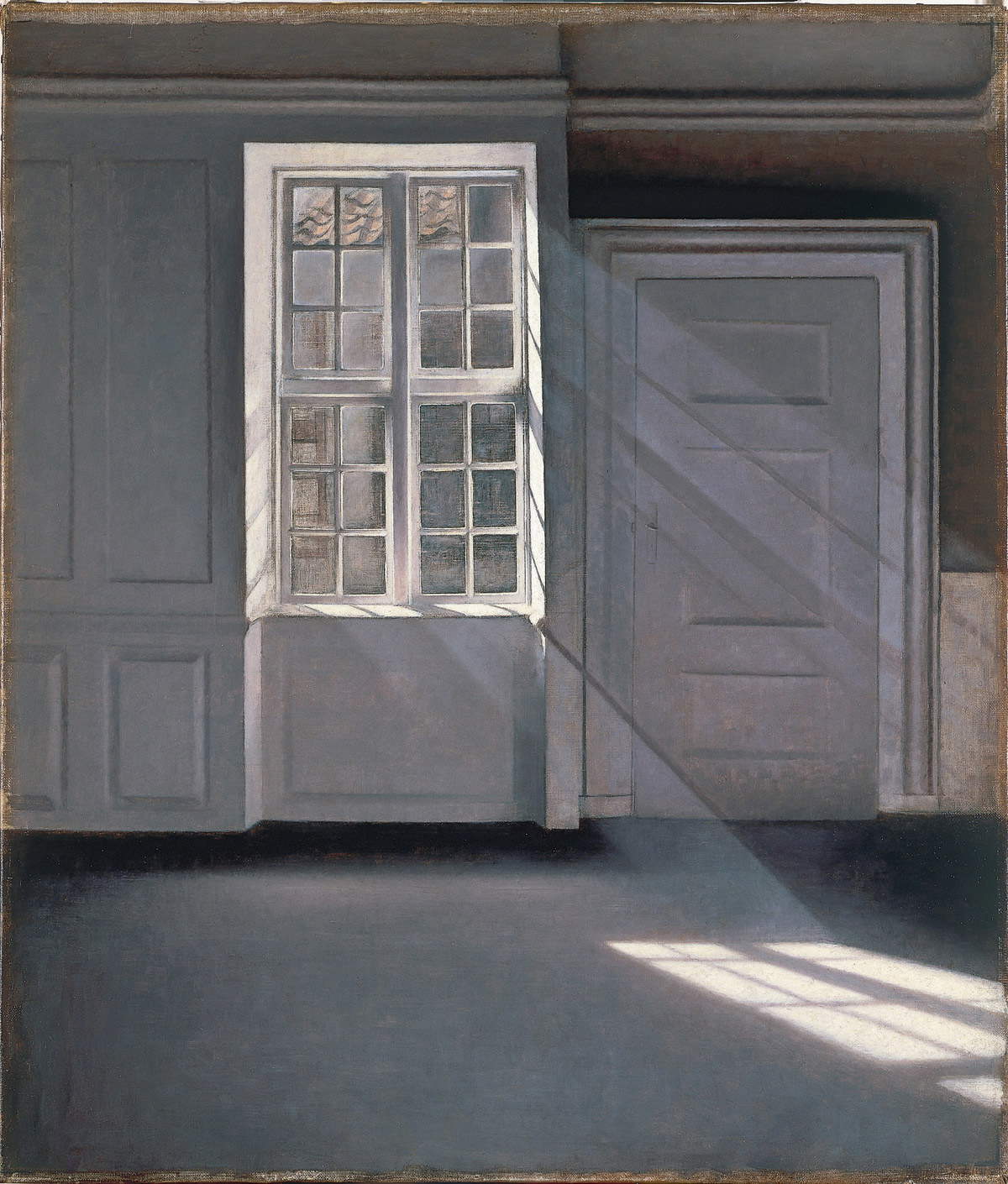 |
| Vilhelm Hammershøi, Interior of the Artist’s House (1900; oil on canvas, 70 x 59 cm; Jægersborg Dyrehave, Ordrupgaard) |
 |
| Caspar David Friedrich, View from the artist’s studio, left window (1805-1806; graphite and sepia on paper, 314 �? 235 mm; Vienna, Belvedere) |
Also worth mentioning is Interior of the Artist’s House, from 1900: here the centerpiece of the composition is the white window positioned on the wall facing the viewer from which the sun’s rays visibly enter, causing the complete reflection of the window on the floor. The interior space appears empty. The motif of the single window, through which light enters, which is the protagonist of an entire painting is reminiscent of the View from the Artist’s Studio by Caspar David Friedrich (Greifswald, 1774 - Dresden, 1840), with the difference, however, that the view outside the window is defined in the latter. Rooftops seem to be glimpsed from Hammershøi’s window, but the whole thing is almost imperceptible.
Hammershøi’s art was greatly appreciated by Czech poet and writer Rainer Maria Rilke (Prague, 1875 - Les Planches, 1926) and he described the Danish painter as one who represented “what is important and essential in art.” it is true that his interiors are dictated byessentiality and simplicity, but Hammershøi’s painting is actually much deeper. It is able to touch the chords of the soul.
Reference bibliography

The author of this article: Ilaria Baratta
Giornalista, è co-fondatrice di Finestre sull'Arte con Federico Giannini. È nata a Carrara nel 1987 e si è laureata a Pisa. È responsabile della redazione di Finestre sull'Arte.
Warning: the translation into English of the original Italian article was created using automatic tools. We undertake to review all articles, but we do not guarantee the total absence of inaccuracies in the translation due to the program. You can find the original by clicking on the ITA button. If you find any mistake,please contact us.